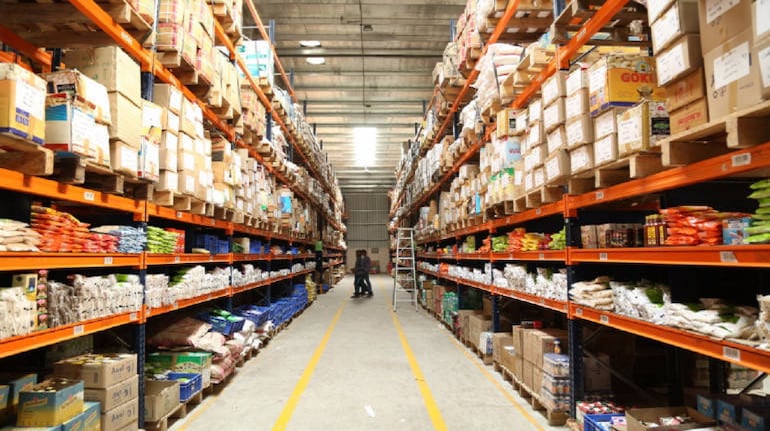



As the government gives a push to manufacturing and e-commerce gains popularity, warehousing is emerging as the next big investment opportunity with multiple players foraying or expanding into the sector.
Recently, Welspun One Logistics Parks has leased over 70,000 sq ft standalone warehousing facility to Third Party Logistics (3PL) start-up firm Emiza. Mahindra Logistics, a 3PL and integrated supply chain company, has leased 6,53,000 square feet of warehousing space in Bhiwandi, near Mumbai, for five years.
Adani Logistics, a subsidiary of Adani Ports and Special Economic Zone, will form a joint venture with the DA Group to develop and operate logistics and warehousing parks.
Read here | Warehousing rents in Mumbai, Bengaluru, Delhi-NCR up 7.2% in FY'22: Report
Earlier this month, the Adani Group approached the Uttar Pradesh government for 700 acres near the Noida International airport to set up an industrial and warehousing complex.
The warehousing rush is spurred by the massive consumption market and the government’s aggressive economic growth targets that may make India into a global manufacturing and industrial giant, according to experts.
Looking at the rising demand, some industry participants even believe warehousing Real Estate Investment Trusts (REITs) will eventually gain prominence.
“The introduction of various favourable initiatives like GST, PM Gati Shakti, and the ongoing national logistics policy, has made the sector more bankable,” Knight Frank’s report quoted Anshul Singhal, Managing Director, Welspun One Logistics Parks, as saying.
Meanwhile, Shaishav Dharia, CEO - of Townships and Rental Assets, Lodha Developers, believes warehousing is still in the nascent stage and that the India story will unfold over the next decade.
“With the focus on Make in India and China+1 strategy since the start of Covid, we have seen a significant increase in industrial demand. Equally, the warehousing sector started with a huge spike in e-commerce demand and then a strong pick-up among logistics companies, retailers, and cold chains,” he said.
Industry participants say the growth in the warehousing and logistics segment was triggered by the pandemic, which accelerated the trend of online purchases.
Among the key occupiers are e-commerce players like Amazon, Flipkart, BigBasket, and 3PL firms including DHL, Delhivery, and Instakart. These firms prefer Grade A facilities with optimised and modernised facilities, said Anupama Reddy, Vice President & Co-Group Head, of ICRA.
Grade A warehouses are comparable with international standards offering extra height, floor load, and high-performance flooring systems. They have access to fire safety protocols and a clean environment among other facilities.
Read here | Mutual funds' SIP collection jumps 31% to Rs 1.5 lakh crore in 2022 on higher retail participation
Shobhit Agarwal, Managing Director, Anarock Capital, sees 15-20 percent annual growth in Grade A warehousing assets over the next three to four years owing to high demand.
The eight primary markets of India comprising Mumbai, NCR, Pune, Chennai, Bengaluru, Kolkata, Hyderabad, and Ahmedabad are estimated to have over 330 million square feet of warehousing inventory at the end of 2023 with nearly 50 percent Grade A capacity, ICRA said.
The rating firm expects the trend to continue in the medium term with robust demand from the e-commerce sector. “The demand from key sectors namely e-commerce, 3PL, and manufacturing also will ramp up capacity addition in the warehousing space,” it said.
Investment and key players
During 2017-2022, the domestic warehousing sector attracted investment of around Rs 26,500 crore, Reddy said.
Key global players with a sizeable presence in the Indian warehousing sector are IndoSpace group, ESR Group, Blackstone Group, and Ascendas-Firstspace, among others.
Prologis, the largest warehouse owner in the world, has drawn up huge plans for the Indian market and plans to build large warehouses near major industrial and commercial centres of the country, as per a report.
Recently, Mirae Asset Credit Opportunities Fund, a part of Mirae Asset Investment Group, purchased a pre-leased Grade A industrial asset at Bhiwandi near Mumbai.
There has also been significant acquisition activity in the sector with examples such as Blackstone’s acquisition of Embassy Industrial Parks and Allcargo’s warehousing assets and Ascendas’ acquisition of Arshiya’s warehousing assets, Reddy added.
The only way to grow is by manufacturing and selling more goods, said Balbir Singh Khalsa - Executive Director & India Head for Industrial & Logistics at Knight Frank India. “So there will be huge logistics and transportation of spare parts or goods or raw material and similarly, finished goods. The stock levels will also increase in warehouses,” he said.
Khalsa believes that the sky is the limit for the sector.
He pointed out that the warehousing sector was projected to grow at a 19 percent CAGR (Compounded Annual Growth Rate) in the FY21-26 period. “FY22 exceeded expectations with a 62 percent YoY growth as the economy rebounded from the pandemic while the next year is also expected to see further growth as economic growth is forecasted to stay on course, the extent of growth in warehousing demand however should moderate compared to FY22 as the market normalises further.”
Read here | Large-caps rule near-term strategy, but long-term belongs to mid-caps, small-caps
However, Khalsa said the only challenge in this sector is getting land parcels. Aggregating or buying large land parcels outside the cities normally is slightly difficult compared to buying a 5 or 10-acre land within the city because it involves buying from farmers.
Discover the latest Business News, Sensex, and Nifty updates. Obtain Personal Finance insights, tax queries, and expert opinions on Moneycontrol or download the Moneycontrol App to stay updated!
Find the best of Al News in one place, specially curated for you every weekend.
Stay on top of the latest tech trends and biggest startup news.